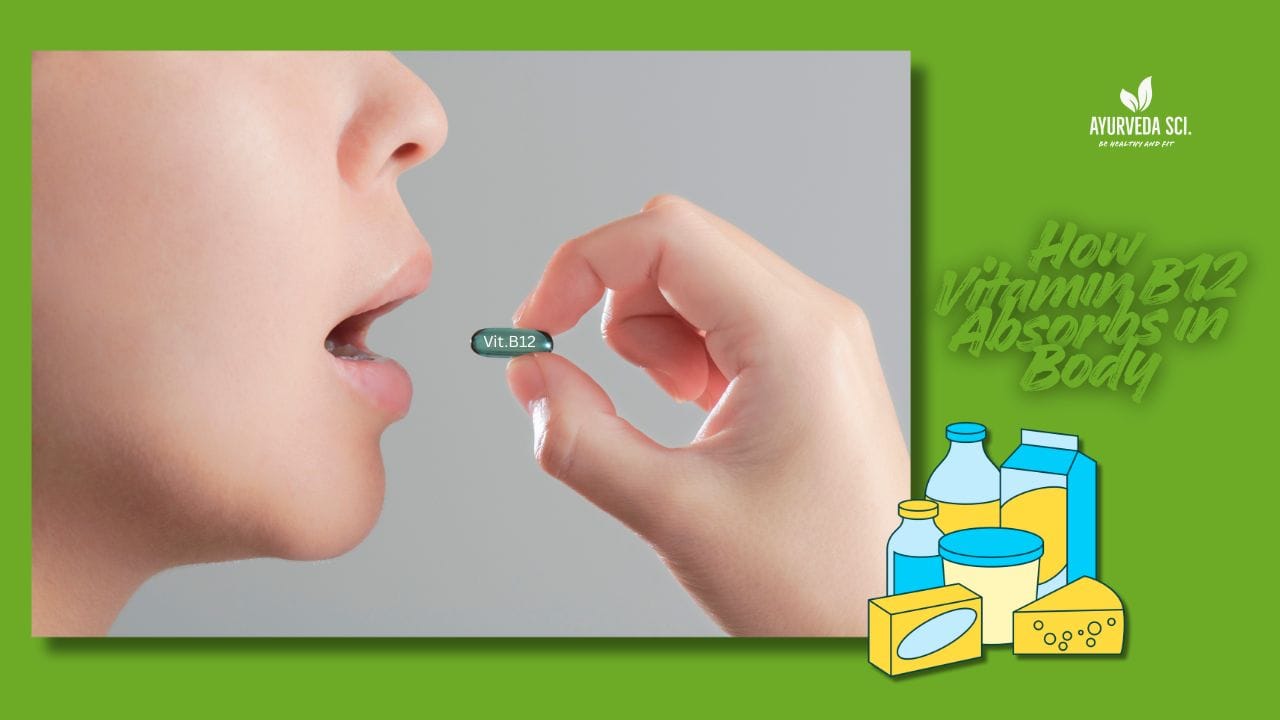Vitamin B12 (cobalamin) has one of the most complex and fascinating absorption mechanisms of all vitamins. Unlike most nutrients that are simply absorbed in the small intestine, B12 requires a multi-step, highly orchestrated process involving saliva, stomach acid, three different binding proteins, and a very specific receptor only found in the last part of the small intestine (ileum). Even a small defect in any step can lead to severe deficiency.
Here is the complete physiological pathway explained clearly:
Phase 1: Release from Food (Stomach)
- Food enters the stomach
B12 in animal foods (meat, fish, eggs, dairy) is tightly bound to animal proteins. - Hydrochloric acid (HCl) + Pepsin
Strong stomach acid (pH 1–3) and the enzyme pepsin break the B12–protein bonds and liberate free cobalamin.
↓ This is why low stomach acid (common with aging, long-term antacids/PPIs, or H. pylori infection) is a major cause of B12 malabsorption even in meat-eaters. - Binding to R-binders (Haptocorrin)
The newly freed B12 immediately binds to R-proteins (haptocorrin) secreted by salivary glands and stomach cells. This protects B12 from being destroyed by the acidic environment.
Phase 2: Handover in the Duodenum
- Pancreatic proteases
When the food bolus reaches the duodenum (first part of small intestine), pancreatic enzymes (trypsin, chymotrypsin) degrade the R-binders and release B12 again. - Binding to Intrinsic Factor (IF)
At the same time, parietal cells in the stomach have secreted Intrinsic Factor (IF), a glycoprotein.
In the neutral pH of the duodenum, free B12 quickly binds to IF.
→ The B12–Intrinsic Factor complex is the only form that can be absorbed later in the ileum.
Phase 3: Absorption in the Terminal Ileum
- Travel through the small intestine
The B12–IF complex travels ~5–6 hours through the jejunum and finally reaches the terminal ileum. - Cubam receptor recognition
Epithelial cells in the ileum express a specific receptor complex called Cubam (made of cubilin + amnionless proteins).
This receptor recognises and binds only the B12–Intrinsic Factor complex (not free B12 or B12 bound to other proteins). - Endocytosis and release
The entire complex is taken into the enterocyte (intestinal cell) by receptor-mediated endocytosis. Inside the cell:
- Intrinsic Factor is degraded in lysosomes
- B12 is released and binds to transcobalamin II (TCII), the transport protein that will carry it into the bloodstream.
- Entry into blood
The B12–transcobalamin II complex (called holotranscobalamin or “active B12”) is secreted into the portal vein and delivered to every cell in the body.
Overall Efficiency
- Only ~1–2% of a large oral dose (e.g., 500–1000 mcg supplement) is absorbed by passive diffusion across the entire intestine (useful for high-dose supplements).
- Normal physiological absorption via the IF pathway: ~50–60% of the B12 present in food (usually 1–5 mcg per meal).
Summary Table: Key Players & What Happens When They Fail
| Step | Protein / Factor | Location | Common Causes of Failure | Result |
|---|---|---|---|---|
| Food release | HCl + Pepsin | Stomach | Aging, PPIs, H. pylori, atrophic gastritis | B12 stays bound → deficiency |
| First protection | R-binders (haptocorrin) | Saliva + stomach | Rare genetic defects | Minor role |
| Handover | Pancreatic enzymes | Duodenum | Chronic pancreatitis, pancreatic insufficiency | B12 stays bound to R-binders |
| Crucial carrier | Intrinsic Factor | Stomach parietal cells | Pernicious anemia (autoantibodies), gastrectomy | Classic B12 deficiency disease |
| Receptor | Cubam (cubilin + amnionless) | Terminal ileum | Ileal resection, Crohn’s disease, celiac | Severe malabsorption |
| Blood transport | Transcobalamin II | Liver synthesis | Very rare genetic TCII deficiency | Neurological damage despite normal serum B12 |
Why Vegans Still Need Supplements or Fortified Foods
Plants do not contain B12 (except inactive analogues in some algae). Even if soil bacteria produce B12, modern hygiene and food washing remove it. The entire elegant absorption machinery described above has nothing to bind to without an external source.
Read More: Early Signs of Vitamin B12 Deficiency: Listening to Your Body’s Warnings
Practical Takeaways
- Low stomach acid → consider betaine HCl or apple-cider vinegar with meals (under medical guidance).
- Pernicious anemia or total gastrectomy → lifelong B12 injections or high-dose sublingual bypass the gut entirely.
- High-dose oral supplements (1000–2000 mcg/day) work even without intrinsic factor because 1–2% passive absorption is enough.
- Sublingual, nasal sprays, and injections all bypass the gut pathway completely.
Understanding this intricate mechanism explains why B12 deficiency is so common despite seemingly adequate intake — and why early testing (serum B12 + methylmalonic acid + homocysteine) is crucial for at-risk groups.

